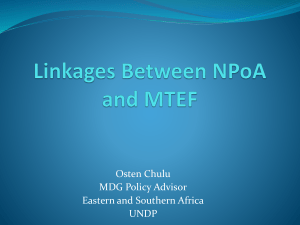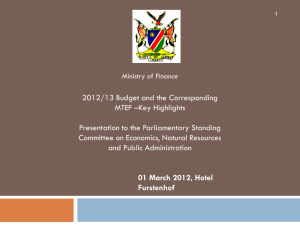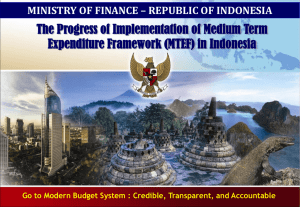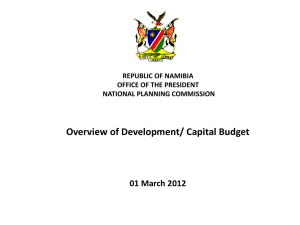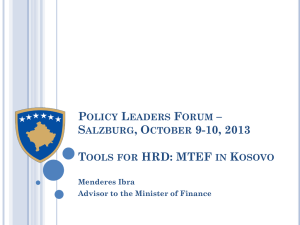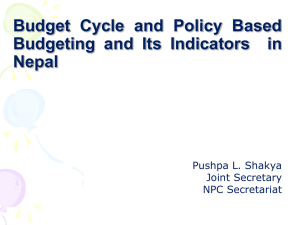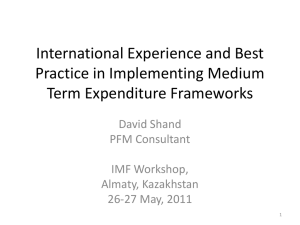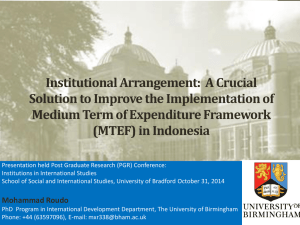MTEF and links to annual budgets
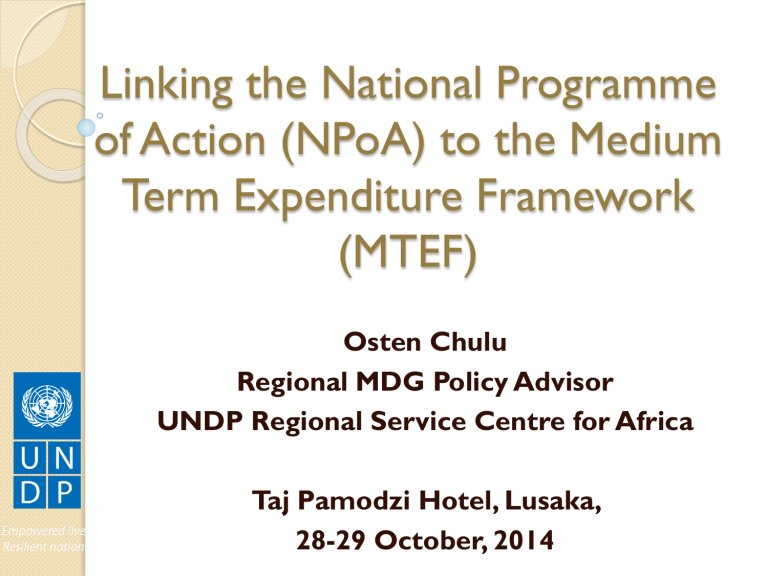
Linking the National Programme of Action (NPoA) to the Medium
Term Expenditure Framework
(MTEF)
Osten Chulu
Regional MDG Policy Advisor
UNDP Regional Service Centre for Africa
Taj Pamodzi Hotel, Lusaka,
28-29 October, 2014
Starting Point – Plans and Budgets
All countries develop NDPs/PRSs/Growth
Strategies (some brilliantly)
Most countries are resource constrained
But most plans start off as unconstrained wish lists
Few are costed – No NAs undertaken
Challenge is to unite the two – Plans and resources (through the budget)
In many countries, the two are unfortunately mutually independent processes
Plans and Budgets
Almost all national programmes and strategies are important to governments
The challenge is prioritization
Methodologies for prioritization are few (e.g., the MAF approach)
There are also challenges in sequencing – which intervention takes precedence?
How do we resource priority interventions? has a Needs Assessment been undertaken?
What about recurrent cost implications?
Many Plans running concurrently
National Strategic Development Plan
Sectoral Strategic Plans
MDG Acceleration Framework
National Plan of Action
Democratic/political governance, economic governance, management and social economic development
Donor-driven initiatives (implemented by line ministries)
“Pet” projects and initiatives
Challenge….
Programmes not matched by resources
Usually the same Govt.
Ministry/department responsible for many of these concurrent programmes
Financing arrangements are weak – not taking advantage of synegies
Resource scarcity leads to “programme greed” – bring anything on as long as there are resources coming – spreading ourselves to thin
Challenge…
Different plans may have overlapping life cycles – How do we synchronize these?
NSDP – MDGs – NPoA?
How do we align expenditure cycles of the
NPoA and the MTEF? Annual Budgets can be used.
NPoA and MTEF level of aggregation – are they the same?
What about financial cycles of donors
(many countries are dependent on these)?
The Medium Term Expenditure
Framework (MTEF)
MTEF – Came about through the need to have a more predictable resource envelope
There is a need to know the amount of resources required to implement interventions
The MTEF facilitates this! MTEF is a potential solution in countries where policy making, planning, and budgeting are in disarray or not property linked with one another. For this reason, MTEF has recently become a central element of many of the public expenditure reform (PEM) programs
What is a MTEF
A tool for linking policy, planning & budgeting over the medium term (3-5 years)
Characteristics
◦ Medium term Fiscal Framework
◦ Estimates of the future costs of existing policies
◦ Sector strategies setting out priorities for future spending
◦ Can also be used for estimates of resource requirements for emerging initiatives such as the NPoAs
Why an MTEF?
Strong linkages between policy, planning and budgeting are necessary for the efficient and effective use of limited resources
◦ PRSPs Identify the medium-long term objectives and priorities for poverty reduction
◦ MTEF provides a framework for allocating resources
◦ The annual budget serves as the instrument for implementing the national aspirations
◦ MTEF provides the ‘linking framework’ which allows expenditures to be driven by policy priorities and disciplined by budget realities
(constraints).
Elements of an MTEF
A top-down resource envelope consistent with macroeconomic stability and policy priorities
A bottom-up estimate of the current and medium term cost of existing national programmes and activities
How far down to the bottom do we go? – cost considerations?
Cost estimation methodologies exist – data challenges are numerous (target populations, coverage, etc.)
An iterative process of decision-making, matching costs and new policy ideas with available resources over a rolling 3-5 year period
Elements of the MTEF
Stages of formulating a comprehensive MTEF include:
◦ (a) developing a macro/fiscal framework which projects revenues & expenditure in the mediumterm;
◦ (b) developing sectoral programs with cost estimates of activities, their objectives, and outputs;
◦ (c) defining a sector-resource allocation strategy based on medium-term sector budget ceilings;
◦ (d) preparing sectoral budgets; and
◦ (e) political approval.
In sum, MTEF will include three pillars: (i) Projection of aggregate resource envelop , (ii) cost estimates of sectoral programs, and (iii) the political-administrativeinstitutional process which integrates the two
What an MTEF can do
If successfully applied, it can
Improve macroeconomic balances by developing a multi-year resource framework
(expenditure and revenue)
Assist in improving resource allocation between and across sectors
Improve predictability of funding for line ministries
Requirements for an MTEF
A clear framework of national objectives, policies and priorities
Realistic medium-term resource projections
Comprehensive budget that enables the budget system to relate results and accountabilities to resource inputs
A budget and programme classification that can be linked to national and sectoral objectives
Monitoring indicators of inputs, final and intermediate outputs and outcomes
TOP-DOWN
STEP TWO
Aggregate fiscal discipline
- Macroeconomic framework
- Multi-year perspective on resources and expenditure envelope
STEP ONE
PRSPs, MDGs and
National plans, priorities
STEP THREE
Ceilings
Political commitment critical
STEP FIVE
Preparation of estimates
STEP SIX
Review and approval of estimates
STEP FOUR
Strategic allocation
- Increase in predictability of sector financing
- Sector expenditure plans, linking policy to budgets multi-year integrated allocation linking local/external financing, capital/recurrent, wage/non/wage, inputs/outputs/outcomes
BOTTOM-UP
The NPoA and the MTEF
NPoA Structure
• Democracy and Political Governance
• Economic Governance and
Management
• Corporate Governance
• Socio Economic Development
Costing Frameworks
PRSP or NDP, inclusive of NPoA, provides the roadmap for policy priorities
Based on the objectives laid out for each NPoA thematic area
Sector Working Group mechanism
(e.g., Sector Investment Plans)
Institutional Mandates and Objectives
(Vote Functions)
Costing Frameworks
Sectoral and institutional objectives
Review of existing initiatives and financing plans
Expected
Outcomes,
Outputs and indicators
From the NPoA to the Budget
NPoA
◦ Thematic Paper on Governance
Plan
◦ Sector Budget Framework Papers
Plan
MTEF
MTEF Budget
◦ Budget Call Circulars, Setting of ceilings etc.
Enhancing MTEF-NPoA Links
NPoA should be incorporated/absorbed into the NSDP
Same macro-framework used for MTEF and
NSDP
MTEF process should cover all sectors
Budget comprehensiveness is key
Opening up the budget making process to stakeholders as part of the development of the MTEF
Improved costing and target-setting –
Prioritization and hard decisions on what to do first
Benefits of MTEF
More realistic budget framework and better alignment with policy priorities such as PRSP
Greater opportunities to fund highest priorities
More accurate reporting requirements such as reporting expenditures
Greater transparency and ownership due to the involvement of and consultation with line ministries, local/regional government units.
Setting up ‘Hard budget constraints’ and tighter sectoral ceilings
Building ‘institutional’ (rules/procedures, etc.) and organizational (agency) capacities at all key levels of budget formation.
Challenges of MTEF
Creating an effective expenditure monitoring/tracking system at all levels of the government and especially at sub-national levels governments.
Implementation challenges due to lack of organizational and human resource capacity at all levels of government.
Inability to prioritize sectoral/regional policies due to lack of political will .
Lack of proper coordination within key policymaking & budgetary units in the government.
Lack of ‘ institutional capacity ’ – i. e., lack of appropriate laws, rules, and regulatory and monitoring procedures in place.
Advocacy
Consensus building
Consistency of economic and social objectives
Setting national targets
Setting priorities
Setting sectoral targets
Estimating costs
Budgeting
Mobilization of resources
Policy coordination
Translate targets into project objectives
Select monitoring indicators
Result oriented management
Participatory monitoring
Monitor process
Linking Outputs with
Outcome and Impact
International Commitments
MDGs. HIPC, WSSD, NPoA
National Policy
Macroeconomic Policy
SNDP
SWAPs etc.
Sectoral Policy
Education Rural Development
Health etc.
Housing
Industrial Policy
Labour,
Policy Implementation
Specific Policies, programmes and projects
Outputs
Outcomes
Impact
Monitoring and
Evaluation
Flexible, Result
Oriented, Participatory
Management
Conclusion
Integrate NPoA into the National Plan/Strategy
Identify gaps and assess the magnitude of difference
Accurate costing , prioritization in the face of limited resources
Capacity development
Implementation, implementation, implementation
What is lagging behind and what can be done about it? MAF methodology customised to local context
Follow-through and feedback mechanisms developed and adhered to
Leadership and political commitment
